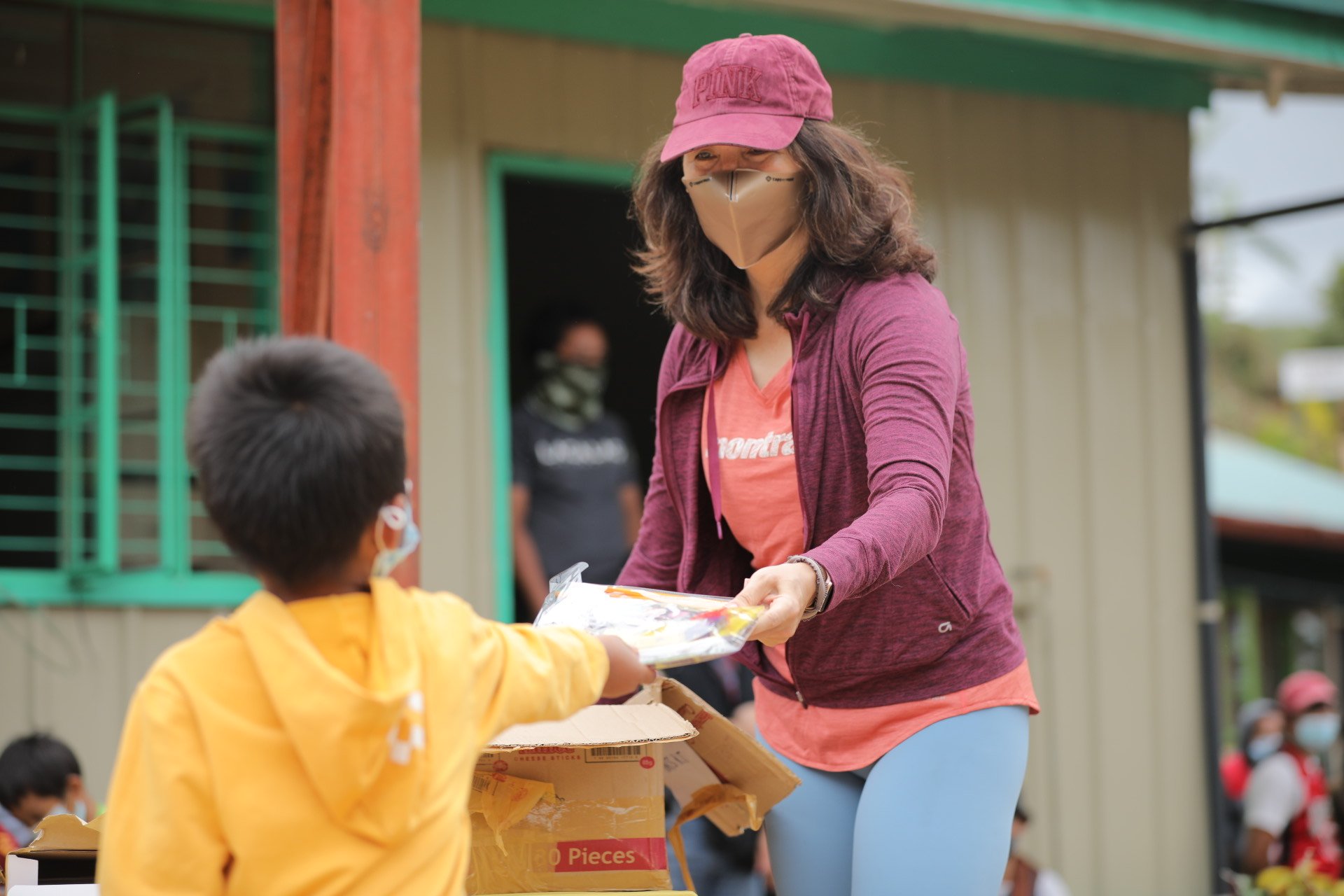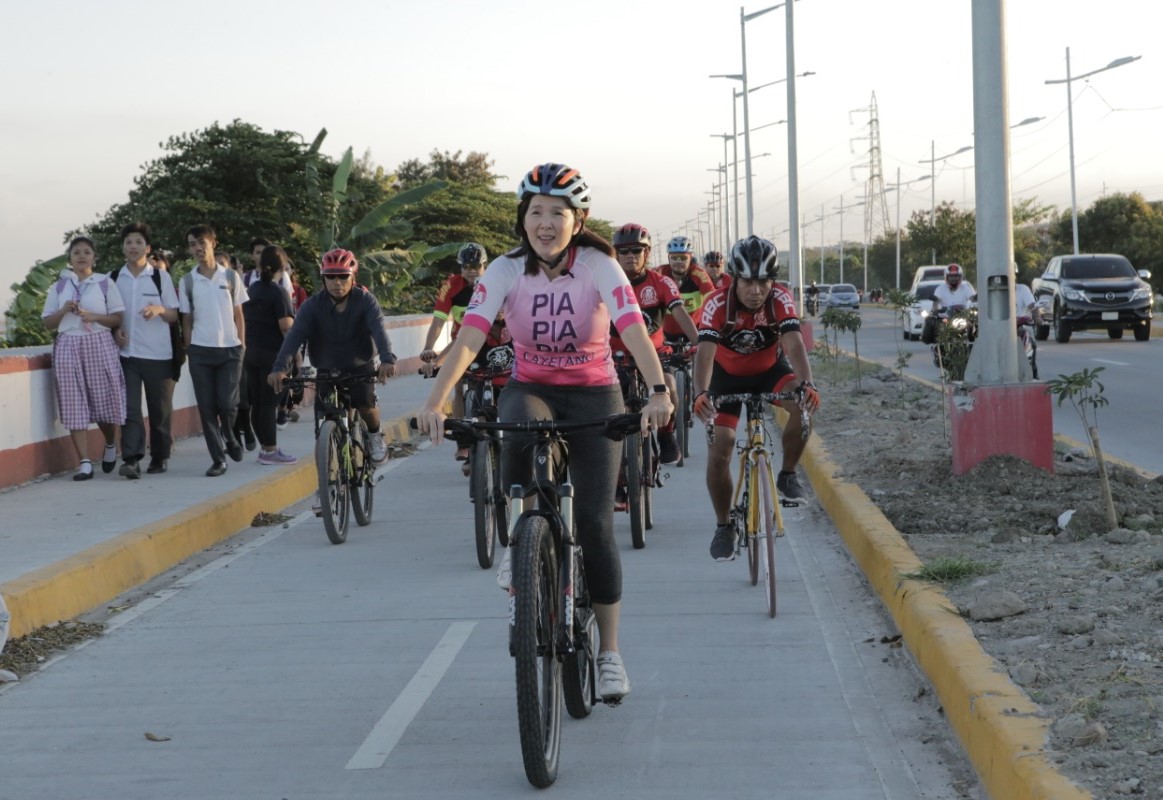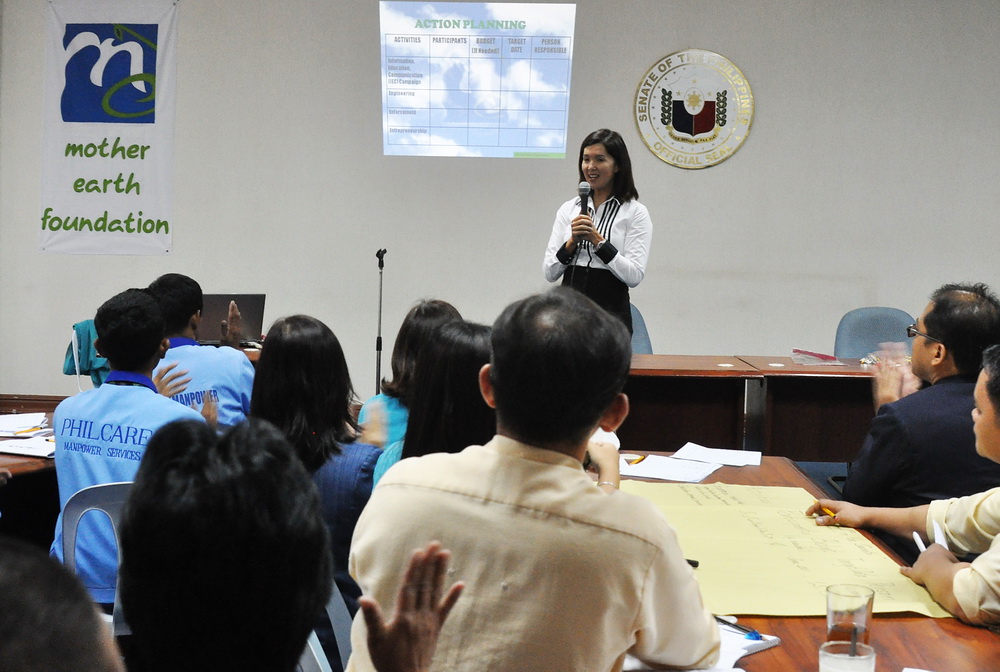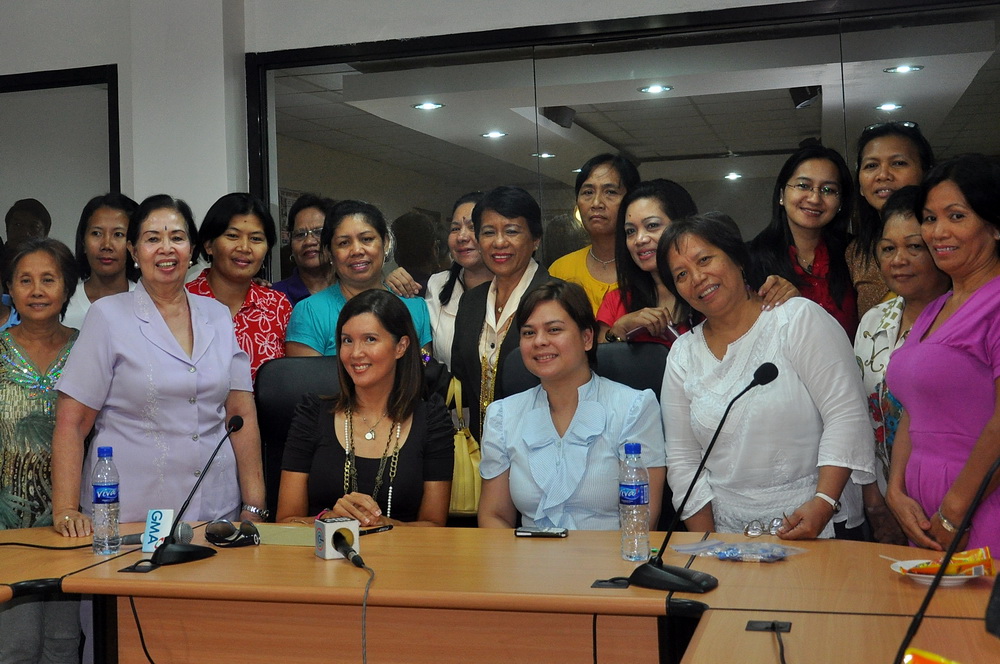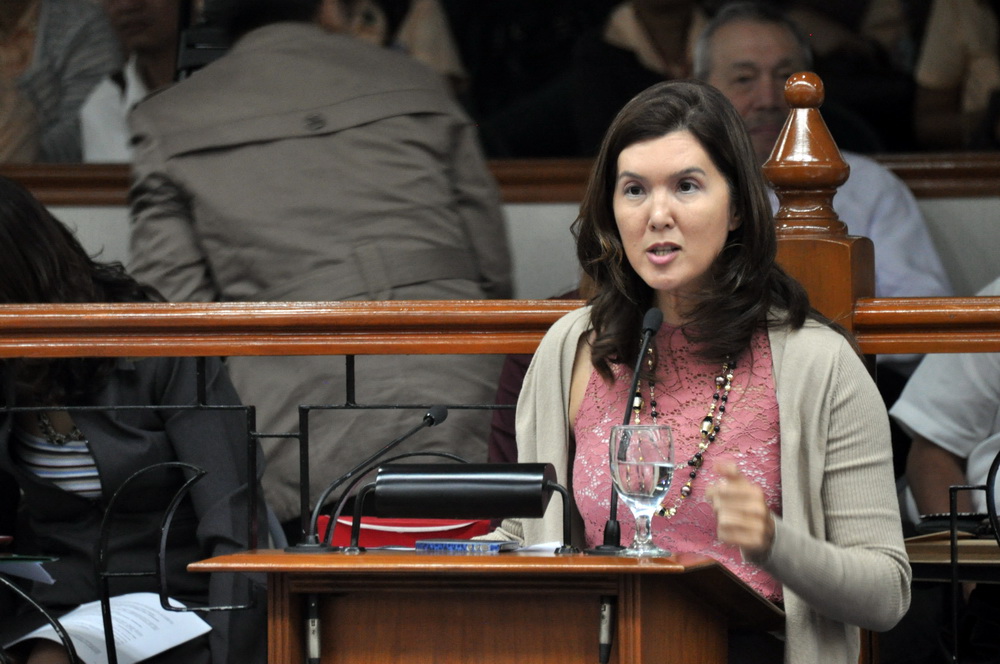I am proud to report that the Philippine Senate has been able to reduce by as much as 50% the volume of garbage it generates Read More
Latest Posts
In Our Own Backyard
The Mayor Sara that I know
Sara Duterte, the feisty, no-nonsense, hardworking mayor of Davao City, a household name in Davao City, is now a household name all over the country.
Three days ago, she punched a sheriff in the face after he failed to heed her request to hold off a demolition order for two hours to avert further violent confrontations between the demolition crew and angry residents.
Immediately people started reacting. Many condemned the act of violence exhibited by no less than the highest elected official of the city. But there were also those who expressed support and appealed for understanding for the Mayor, who they said acted out of frustration after the sheriff refused to listen to what appeared to be a reasonable request from her.
I myself do not condone the use of violence. But let’s look at the circumstances that led to this unfortunate event.
For days, Sara had been in the forefront of relief operations for the flood victims in her city. Earlier that week, Davao City was hit by continuous heavy rains, causing flash floods that killed at least 30 and displaced 13,000 residents in five barangays. In the midst of the city government’s relief work, the impending demolition of the households of 217 families in Barangay Soliman is brought to her attention. Inday Sara is very familiar with this scenario. And in her desire to avoid an outbreak of violence, she requests the sheriff to wait a few hours so she can get there and manage the situation.
Imagine her frustration and perhaps, anger, upon learning that the demolition had pushed through despite her request. She rushes there and arrives at the “battlefield.” On one side, the enraged residents ready to stake their lives to defend their homes. On the other, men in uniform dedicated to performing their job. Both groups trust her. Both deeply respect her as a person and the position she holds. Sara knew this was not a win-win scenario. Emotions run high when people are fighting for their homes. And yet, she fearlessly walked into that “war zone.” Violence had already erupted when she arrived. In fact, in an article in the Inquirer, the urban poor group Kadamay reported that ten (10) residents were wounded, including a 12-year old girl, in the violence that broke out at the site before she arrived. And yet, she risked her own safety and security by going into a “battle zone” at a time when tempers from both camps were already running high.
I can understand Mayor Sara’s deep sense of frustration. This confrontation and the violence that erupted could have been avoided if only her simple request to delay the demolition by a few hours was given due respect and consideration.
I have seen Inday Sara at work. I have known her since she was Vice Mayor. A few months ago, I visited her, just to touch base with a fellow woman leader. We discussed common areas of concern like health care, education and livelihood. We had a dialogue with some of Davao’s women leaders and media practitioners. Incidentally, Mayor Sara is Davao City’s very first woman mayor since it was established in 1936.
Sara is her father’s daughter just as much as I am mine. Now the Vice Mayor, former six-term Mayor Rody Duterte is widely credited for his peace and order campaign that started in the nineties which dramatically reduced the crime rate in the City. He had the political will to push for and enforce progressive ordinances that many cities are still struggling with today, such as the smoking ban, firecrackers ban, reproductive health programs and the Woman’s Development Code, which is the very first such ordinance in the country.
Like her father, Mayor Sara, fondly known as “Inday Sara” is loved and respected by her people. But their trust and affection for her goes beyond the fact that she is the daughter of their former beloved Mayor. You cannot buy the kind of love the Davaoeños have for her. Her father could not have passed on the kind of respect his people have for him if she was undeserving.
In the 2010 election, then the incumbent Vice Mayor, Sara ran for mayor and won by a landslide. She had earned her people’s respect. Through years of dedicated service, the people of Davao City have come to love their hardworking, no-nonsense woman leader. One year into her first term as mayor, the younger Duterte cannot be dismissed as a mere substitute or seat-warmer for her father. In many ways, Mayor Inday Sara has proven that she is her own person and has clearly distinguished herself as an effective local executive.
Two days after the July 1 incident, Sara did what few politicians do. She owned up to her action. She expressed her regret, apologized to the judges, sheriffs and employees of the Hall of Justice, and admitted in an interview that her action was “not [her] best moment.” In fact, she has gone on leave to allow a full investigation to take place. She is willing to take the consequences of her action.
The sheriff’s job of implementing court orders is ministerial, meaning he has no discretion in executing such order. But a delay of a few hours wouldn’t have hurt, especially if it would prevent violence from erupting, avoid injuries from both camps and possibly even the loss of lives.
I do not suggest that we condone any act of violence. But as every law student knows, the Revised Penal Code includes passion and obfuscation as a mitigating circumstance. Clearly the good Mayor was enraged by the fact that the sheriff ignored her request; a request that was born out of wisdom that can only be gained from personal experience in handling delicate situations like this, coupled with a genuinely compassionate heart.
Condemn the act of violence—yes, without a doubt. But to cast judgment on Sara, call her names and judge her —until you have walked in her shoes — that is not your place, nor mine. I don’t believe anyone of us has the right to hastily cast judgment on her. That is for the Department of Interior and Local Government to determine after it investigates the circumstances around the incident. The DILG Secretary has likewise proven himself as an excellent local government leader. If anyone can resolve this fairly and with circumspection, Secretary Jesse Robredo can.
My Vision of a Better PhilHealth
I do believe the changes we are proposing will make PhilHealth more responsive to the health needs of the Filipinos.
1 June 2011
Senate of the Philippines
PhilHealth Amendments
On June 1, 2011, I sponsored Senate Bill No. 2849 which amends the existing PhilHealth law or Republic Act No. 7875.
I had to take time to educate myself and spend a lot of long hours, including ice packs for my headaches and at night, after working, drink chamomile tea to help my brain shut down and rest. My staff worked overtime on this bill too and in a future blog, I should write about how they coped with the long hours.
I apologize in advance because this blog entry is a bit heavy and technical. Whether I am drafting a senate bill, writing a committee report or my blog, I always try to simplify the technical terms used. Legal phrases and procedures are easier for me to explain because of my legal background. But medical and financial terms are of a different class altogether. So, I am warning you, there is a fair share of medical and health financing terms used here.
During numerous hearings and technical working group meetings, it was revealed that in the 16 years since PhilHealth has been in effect, it has failed to cover many Filipinos, particularly the poor who are in dire need of health care. Philhealth now provides a wide array of benefits. But without Philhealth membership they have to pay for all their medical expenses.
The other problem is for those who are already members – many are still unable to use their Philhealth benefits because the out-of-pocket expenses they need to shoulder are way too high.
Thus, my bill aims to resolve the current problems as follows:
1. Universal coverage
- Section 17: all Filipinos shall be enrolled in the PhilHealth program.
- All Filipino citizens will have to be properly categorized as (i) indigents, as may be identified by a means test to be conducted by the National Government, (ii) members of the informal sector, (iii) practicing professionals and self-earning individuals, and (iv) the formal sector, or those whose PhilHealth premiums are automatically deducted from their salary.
- The bill further identifies who will pay for the premiums of the different categories:
- Indigent- national government
- Lowest income level earners of the informal sector- local government, legislative sponsor or other sponsors; or
- Able and capable- oneself
- Section 6: mandates that no Filipino shall be denied access to basic health care services, which are identified in the bill. Further, no woman who is about to give birth shall be denied maternal and newborn care.
2. Lower out-of-pocket expenses
- The poorest of the poor are not able to avail of health care services because they need to shoulder more than half of the total expense which is considered out-of-pocket expenses, thus, a shift to case-based payment from the current fee-for-service arrangement is proposed in this bill. And this is where I spent many hours understanding how these payment systems work. I also tried to simplify the definition of the terms.
- Section 2:
- Fee for service payment which is defined in as a fee pre-determined by PhilHealth for every single test conducted, every drugs and medicines given, and in addition, for the professional fee and hospital bill.
- Case-based payment scheme which is where the treatment of a certain disease, from diagnosis to cure is charged a one fixed package cost.
- Section 6: PhilHealth and DOH shall annually study the services being offered to determine its financial sustainability and relevance to health innovations with the end in view of reduced out-of-pocket expenditure, among others.
- Section 15 further directs that the excess reserve funds will be used to meet the principles of the bill, one of which is to reduce out-of-pocket expenses.
3. More efficient allocation of funds
- To reinforce the focus on preventive and primary health care, the bill provides for community-based services in the form of Essential Health Care Packages and per capita payment- based services.
- Section 2:
- Essential Health Packages refers to a variety of health care packages consisting of promotive, preventive, diagnostic, curative and rehabilitative services that respond to the needs of the community.
- Per capita payment refers to a pre-determined fixed rate paid to a health care provider to provide a defined set of services in the community for a fixed period of time for each enrolled individual.
- Capitation. Capitation is the amount paid by PhilHealth to an LGU for every indigent that an LGU enrolls. Section 22: directs the LGUs to invest this capitation fund solely on health infrastructures or equipment, professional fees, drugs and supplies or information technology and database.
4. Other Features of the Bill
a. Reserves
- Under the existing law, Philhealth is allowed to save two years worth of its projected expenditures as “allowable reserve fund.” This has been highly criticized because Philhealth is suppose to spending the funds on health care services instead of saving it as if it were a bank. Thus, under this bill, Philhealth is limited to save for its reserve fund an amount equivalent to projected expenditures for only one year. Any excess in the actual reserves will be used to meet the principles stated in the bill, which is to expand the health care benefits of the people.
b. Information technology
- The bill mandates that PhilHealth should invest in the acceleration of its information technology systems.
- It should maintain and secure a database of all its enrollees to ensure universal coverage.
- The bill obligates the PhilHealth to diligently educate its users of health benefits, and of their rights and privileges under the law.
I am ready to defend this bill on the floor. I do believe the changes we are proposing in this measure will make PhilHealth more responsive to the health needs of the Filipinos. But the filing of this committee report is just part of the process and the bill will now be scrutinized by my colleagues. I am looking forward to their inputs during the periods of interpellation and amendments so we can make this an even better bill.
Full text of Sponsorship Speech of SB No. 2849
Behind the Scenes
Do not be fooled. That is not a girls’ lunch out or is it a summer weekend tea party. It is just a regular summer working day for me and my staff.
During the senate summer recess and even after session resumed, we continue to work either at the office, in my house or out of town.
This is just one of the regular workdays we had in my house.
Now that we are working on the final drafts of both the PhilHealth and Reproductive Health bills, we have been spending even more late nights and weekends working from my house. That is Atty. Joei and me and the Reproductive Health bill.
After years of not having much of a living room, everything finally fell into place. The right sala set, big enough to accommodate a large group but still cozy enough for just my kids and I to laze around in at night. The right round table, perfect for breakfast or group meetings like that shown in the pic. Actually that table and chair set belong to my parents. We kind of borrowed it when I celebrated my birthday two months ago, and have been enjoying it ever since.
I like to think of my home as an alternative work environment for my staff where they can be more relaxed while still getting the work done. As you can see, professional work clothes are not required. (Sidenote on that: My Chief Of Style…Oops! Chief-Of-Staff, DG, wore a brown mid-knee romper for work the day before. Inspired by her summer-friendly attire, I decided to wear a summer outfit the next day. So on the next day, I wore a denim romper only to find out that DG outshone me when she showed up in a bright colored romper with splashes of yellow, orange and pink. But that is fine, I am more than happy that she can freely express herself.) They are also free to raid my kitchen and my stash of chocolate (Although, I do hide that well). They are also free to swim in my little backyard pool, although so far, the only ones who have used the pool are the kids of my Chief-Of-Staff, who take their swim lessons there with my triathlon coach.
Working from my house necessarily includes an invitation to do a sunset trail bike run or swim. See that floral arrangement on the table? When I asked who would like to go for a run later, Mich, my researcher, actually tried to hide behind it! As if I didn’t know she was there! Oh well, there is always Che, my ever-reliable executive assistant/political-international relations officer. She won’t back down on any invitation to run whether it be under the sun or in freezing weather.
But like I said, do not be fooled by the homey atmosphere and the floral prints. My legislative team is lean and mean. The bills we have been toiling over will be out soon. Then we go to the next stage, which is defending them on the senate floor. Meanwhile, I would like to think that I provide an employee-friendly, women-friendly, child-friendly working environment for my staff.
Murder At Sea
Today, I woke up to a very disturbing headline in the Philippine Daily Inquirer, entitled “Coral Reefs Twice Size of Manila Destroyed”. Last Tuesday, officials from the Bureau of Customs reported that a “reef complex” off the coast of Cotabato Province was obliterated, destroying coral reefs and killing other marine life. In the opening paragraph of the article, “the crime was described as the ‘rape of the ocean’.”

What are the applicable laws?
- Section 27(a) of Republic Act No. 9147 entitled “Wildlife Resources Conservation and Protection Act” penalizes illegal acts such as “(a) killing and destroying wildlife species…” Section 28 of the same law states that any person found guilty of such illegal act shall be imposed with “(b) imprisonment of four (4) and one (1) day to six (6) years and/or a fine of Fifty thousand pesos (P50,000.00) to Five hundred thousand pesos (P500,000.00) if inflicted or undertaken against endangered species.”
- Section 91 of Republic Act 8550 or the “Fisheries Code of 1998”, outlaws “any person or corporation to gather, possess, sell or export ordinary, precious and semi-precious corals whether in raw or in processed form.” Any person found guilty of such act is penalized with six months to two years imprisonment and a fine from P2,000 to P20,000 or both at the discretion of the court.
- The Convention on International Trade in Endangered Species of Wild Fauna and Flora prohibits the the collection and harvesting of endangered species such as coral reefs and sea turtles. We are a party to the Convention, and are bound by the same.
My work in the Senate
On numerous occasions on the Senate floor, including budget deliberations/hearings, I have continuously called for the increase in budget allocation to protect our resources. I know that the Department of Environment and Natural Resources has actively sought for the same, reverberating the call for more budget for the environment. Unfortunately, this was a low priority of the previous administration. Perhaps this would serve as a wake up for the current administration.
On my part as a legislator, I have filed and sponsored on the floor a number of bills declaring various areas in the Philippines as protected areas. To name a few, these are the protected area bills which have been enacted into laws:
- Republic Act No. 9847 “Mounts Banahaw-San Cristobal Protected Landscape (MBSCPL) Act of 2009”
- Republic Act No. 10067 “Tubbataha Reefs Natural Park (TRNP) Act of 2009”
- Republic Act No. 9486 or “Central Cebu Protected Landscape Act of 2007”
- Republic Act No. 9494 or “Mimbilisan Protected Landscape Act of 2007”
Aside from these, I have proposed budget amendments for the protection of areas covered by the aforementioned laws and certain protected areas found in the provinces of Occidental and Oriental Mindoro, Bukidnon, and Davao.
One effective model for the protection of both marine resources and forests is to empower the locals thru education and awareness programs to protect their own environment. I have been supporting and pushing for more eco-tourism projects as well. This has proven to be successful in pilot projects across the country.
But despite the existence of these laws and international convention, for as long as the demand on our precious marine life remains, these crimes will continue. As a people, we must unite and declare war against these poachers and murders of our marine life. Government authorities must act with haste. It is important that we show our determination in prosecuting these heinous offenses. These criminals must be put behind bars and made to pay for their crimes.
Smoking Kills
The statistics…
Tobacco use kills more than five million people per year. It is responsible for 1 in 10 adult deaths.
Every eight seconds, someone dies because of smoking-related diseases like chronic obstructive pulmonary diseases and heart diseases.[1]
Among the five greatest risk factors for mortality, it is the single most preventable cause of death. But, if the current patterns continue, tobacco use will kill more than 8 million people per year by 2030. Up to half of the world’s more than 1 billion smokers will die prematurely of a tobacco-related disease.[2]
In the Philippines, 34.8% of our population is engaged in tobacco smoking. What is more disturbing is that children as early as nine years old smoke.[3]
For every cigarette stick smoked, a smoker loses at least five minutes of his precious life and also endangers the lives of innocent people around him whose only fault is that they did not forget to breathe.
As Chairperson of the Senate Committee on Health and Demography in the 14th Congress, I heard and then sponsored the bill mandating picture-based warnings on tobacco products (SB 2377).

We need the bill to deter new smokers, especially among the youth, try to lessen the urge of existing smokers, as well as implement our commitment under the Framework Convention on Tobacco Control (FCTC), which is an international treaty initiated by the World Health Assembly. It is the first global public health agreement devoted entirely to tobacco control to which the Philippines is a signatory and which was participated in by 192 countries.
The Philippines acceded to the FCTC in 2005 obliging us to comply with certain standards, such as tobacco price and tax increases, tobacco advertising and sponsorship, illicit trade and second-hand smoke. More importantly, the FCTC recommends implementing effective measures on packaging and labeling of tobacco products, such as the adoption of a picture-based health warning on tobacco packages.
I defended this bill on the floor and was hoping it would pass, but there was strong resistance from some senators. It was very disappointing.
Meanwhile, a similar bill filed in the House of Representatives was not prospering either, also due to the resistance of some lawmakers.
Soon after, then Secretary of Health Esperanza Cabral came out with DOH Administrative Order 2010-0013 which mandated that graphic health warnings be placed in tobacco packages in accordance with our obligation under the FCTC.
This was a move I fully supported and was happy to see implemented.
Unfortunately, the tobacco companies filed a petition questioning the legality of DOH AO 2010-0013 and seeking to prevent the DOH from implementing the same. An injunction order restraining the DOH from implementing the AO was granted by a Regional Trial Court of Malolos, Bulacan. Thus, the DOH filed a petition with the Supreme Court to question the decision of the lower court.
Former Health Secretaries Francisco Duque III, Jaime Galvez-Tan, Alberto Romualdez, Alfredo Bengzon and Esperanza Cabral, then filed a Motion to Intervene in the Supreme Court case citing that as former health secretaries, “it is our moral responsibility to continue to protect public health interest from an industry that fosters disease and death in its regular course of business.” They also said that “the meddling of the tobacco industry is preventing the DOH from carrying out its mandate to protect and preserve the health and lives of Filipinos.”[4]
In April 2011, the Supreme Court granted said Motion to Intervene.
The mandate for tobacco products to bear graphic health warnings should no longer be a subject of great debate. Studies show that graphic health warnings are effective.
![tobacco] tobacco]](https://mydailyrace.com/blog/wp-content/uploads/tobacco1.bmp)
In Brazil, two thirds of smokers (67%) said the warnings made them want to quit.[5]
In Canada, nearly half of smokers (44%) said the warnings had increased their motivation to quit.[6] More than one quarter of smokers (27%) also smoked less inside their home as a result of warnings.[7]
In Singapore, more than one quarter of smokers (28%) said they consumed fewer cigarettes as a result of the warnings[8]and one out of six (14%) of smokers said they avoided smoking in front of children as a result of warnings.[9]
In Thailand, nearly half (44%) of smokers said the pictorial warnings made them “a lot” more likely to quit over the next month.[10]
Now in the 15th Congress, I have re-filed the Senate Bill No. 2340 or the “Picture-Based Health Warning Law”. As Chair of the Committee on Health, I intend to hold a hearing soon. I know the tobacco lobby is strong but policy makers and legislators should not hesitate to support policies and legislation that will promote the health of Filipinos. This is mandated in Sec. 15 of the Philippine Constitution which says that “the State shall protect and promote the right to health of the people and instill health consciousness among them.”
Tobacco products have been proven to be hazardous to people’s health. The tobacco companies are not being prevented from conducting business. But since they are selling a hazardous product, they should be responsible corporate citizens and comply with policies that are pro-health.
My Thai Princess
6 to 9 January 2011
Bangkok, Thailand
I have visited Thailand for various reasons. In 2007, I was there to cheer for our national team during the Southeast Asian Games. I have joined a number of triathlons there, including last year’s 70.3 Ironman Asia Pacific Champs in Phuket. I have also been there to study their land registration system in connection with a bill I filed in the Senate to streamline our land registration and prevent double titling.
My last trip was with my daughter Max who turned 16 years old this year. My little baby girl. My first born. She is now just a few inches shorter than me. She is growing up so fast. I wanted to spend time with her. I decided to take her on a trip. We chose Thailand.
When I travel with my kids, I always try to include a tour that will expose them and help them learn more about the city or country’s history and culture. For this trip, we went on a river boat cruise. We had a lively guide who filled us with details of Thai history and customs. As we moved along the Chao Phya River and klongs (canals), she pointed out different structures and explained their significance.
When we got to the Wat Arun or the Temple of Dawn, we got off the boat and roamed around. It was a beautiful temple made of broken ceramic. I dream of building something like that here! We climbed the temple. The steps were very very steep.
Max wanted to explore on her own, so I let her.
According to the website of the Tourism Authority of Thailand:
“The temple was built during the Ayutthaya period and was originally called Wat Makok after the name of the local village Tambol Bangmakok. It means “Village of Olives”. Wat Arun gets its name from Aruna, the Indian god of the dawn, hence its common name The Temple of Dawn. The location of the temple is in the area that used to be occupied by the palace of King Taksin who re-established the Siamese Kingdom after the fall of Ayuttaya more than two hundred years ago. The main Buddha image is believed to have been designed by King Rama II. Wat Arun, often called The Temple of Dawn, is one of the most remarkable visual identities of Bangkok. The imposing Khmer-style prang or tower is 67 metres tall and decorated with bits of porcelain that was used as ballast by boats coming from China. It is surrounded by four smaller prangs. Construction of the prangs were started by King Rama II and completed by King Rama II.”
When we got down, she wanted to try on the costumes. So she did. Whoa! Suddenly, my Filipina daughter was transformed into a Thai princess.

I am not Thai. We have no Thai blood as far as I know. But look at this child of mine, does she not look like a Thai Princess?
After that fun picture taking session, we went back on our boat, learned a bit more about Thai culture and finished our cruise.
A Blessed Mother's Day
I woke up this morning and immediately noticed that my daughter, Nadine, was not beside me. A few minutes later, she and my other daughter, Max, walked in the room with my breakfast on a tray- a full breakfast that Nadine cooked!
She made me French toast with lite whipped cream, cinnamon and lite syrup. Then, there was a separate plate of scrambled eggs with strawberries and sliced bananas on the side.
I do not have a big appetite when I wake up because my body and, I guess, my stomach has gotten used to a quick meal of oatmeal, fruit or whole wheat toast with peanut butter or cheese, before running out the door to exercise. So, I asked my girls to enjoy the big breakfast with me. It was delicious!
They also gave me beautiful flowers. Nadine proudly pointed out that they were saving money and the environment by: (a). making my mother’s day card on used paper; (b). using the left- over egg from the French toast to make scrambled eggs; and (c). giving me flowers that were in a vase downstairs. In other words, flowers that were already mine. Haha!
In the evening, my kids and I joined my brothers to celebrate mother’s day with my mom in her house. We had a casual meal, picnic style, eat on the floor or any vacant seat you can find. Recycled food this time – delicious left-over pasta from last night. My mom was happy that we were all together.
I had a wonderful mother’s day. My children have blessed me in so many ways. I can only hope that all the mothers out there are equally blessed. Meanwhile, session resumes tomorrow, and I go back to defending mother’s lives on the floor and in my hearings.
Subic International Triathlon 2011
30 April 2011
Subic Bay Freeport
Every year, the Subic International Triathlon (SUBIT) is on my calendar. I have missed it more often than I have joined it for various reasons. Last year, I missed it because of the senatorial campaign. Although I was running and biking throughout the campaign, I did not have time to swim, plus I could not because just before the campaign ended I broke a bone in my hand and was campaigning in a cast.
This year, I have been on the trails on my mountain bike more than on the road on my tribike. But I switched to more road-tri specific training the last few weeks to prepare for the SUBIT race.
On race day, I was sleepy in the morning as usual. I have an alarm set in my phone for 3:45am which is my usual wake-up time on race days. I am familiar with Subic and the olympic distance is short in comparison to the 70.3 Ironman’s which I often join, so I was quite relaxed. I enjoyed the swim. I am not fast, so to just finish comfortably is good.
The bike leg was good. I like the hills in Subic. Though they are tough, they are not as long as some other hills I have climbed.
The run is always hot. There is little shade along that part of Subic, except for the area by the church which is the only significantly shaded part of the race route. The best part to run is by the transition area and where the finishers come out of the finisher’s chute because friends and supporters wait in this area and their energy and cheers are worth more than a shot of gel.
While I was running my third loop, I saw Anton Tangan, a triathlete and good friend. We have been doing triathlons together for some years now. I said to him, “Anton, nakakapagod pala ‘to”. His reply, “Pa-picture muna.” That made me laugh.
Oh, and there’s the new “green triathlon’ theme. I took that seriously and looked for all the trashcans for my used cups and sponges. There were not a lot. So if I missed the trash can right after the aid station, I would have to carry my cup and stuff my sponge in my trisuit. On the third and fourth round, I started tossing them to my friends on the road, telling them “Please throw this for me.”
It always feels good to see old familiar faces when you are racing. But I also saw so many new people out there. I tried to cheer them on when I ran beside them. After I finished my race and cooled off under the shower, also my favorite part, I ran in the opposite direction of the run course and cheered for the rest of the women and relay participants on the course.
It was a good race for me. I finished first in my category.
Congratulations to all, especially my girl friends, the super girls who I idolize and set a higher standard for all of us. You rock girls! And my training partners, Belle and Coach Noel, who both podiumed and Steve Bonz for doing an amazing 2:42 for his first tri!
For more pictures, please visit https://www.facebook.com/media/set/?set=a.219972164695877.72738.175169705842790.
Sorry, I only have photos from the women’s race held on the first day. I was not able to watch the men’s race the next day because I went home to be with my kids… ’til the next race guys!
Film Showing in Barangay Ayala Alabang on the State of Maternal & Child Health
26 April 2011, Tuesday
Alabang Country Club, Ayala Alabang Village
Film Showing on Maternal and Child Health
Last March I sponsored a film showing on the “state of maternal and child health in the Philippines” in the Senate. After the film showing was an open forum to discuss the thoughts and reactions of the viewers. We felt that the film was a great way to educate people on the plight of women and the issue of women and child health, and thus launched a series of film showings throughout the country.
Last week, I showed the films in Barangay Ayala Alabang Village where I live. We invited residents and different groups including, former Health Secretary Esperanza Cabral, a resident of Alabang and the barangay officials who, unfortunately, were unable to attend. Early this year, Barangay Ayala Alabang enacted Barangay Ordinance No.1, Series of 2011 which, among others, expanded the definition of abortifacients and restricted the use of contraceptives within its jurisdiction. I raised my concerns on the said Ordinance in a letter I sent to Muntinlupa City Mayor Aldrin San Pedro. (Below is the text of the said letter).
These films were among the entries in the recently concluded 2nd Quisumbing Escandor Film Festival (QEFF2) sponsored by the Mu Sigma Phi Fraternity of the University of the Philippines College of Medicine.
The Alabang film showing featured five films – four short films and one documentary, namely:
- Sa Direksyon ni Makoy: Da Final Cut (QEFF2 Jury’s Pick for Best Short Film) Directed by Genevieve Caberte
- Badong Buntis
- Ang Ina (QEFF2 Jury’s Pick for Best Documentary), Directed by Mr. Donnie Sacueza
- Tinalikdan, Directed by Edgar Baltazar
- Limang Libo (QEFF2 Grand Prize Winner), Directed by Aiza Jane Idanan
*For more details on the films, please log on to senatorpiacayetano.com or pinayinaction.com
Many of us have strong opinions on the topic of Reproductive Health, but very few know what the lives of women who have no access to health services are like- how the lives of their children and spouses are affected. Unless we walk in their shoes, we have very little understanding of their sufferings and the day to day difficulties they deal with.
These films tell their stories. They highlight the sad reality that the Philippines has the highest maternal mortality in the region. 11 mothers die each day. 500,000 abortions occur every year.
After the films were shown, we had a forum which was moderated by Dr. Bryan Lim of our partner organization, Mu Sigma Phi Fraternity. It was a lively discussion. I tried to answer questions raised and clarified misunderstandings on a number of issues. Dr. Gregorio T. Alvior, Jr. of the PGH Foundation also answered many questions.
Once again, I thank the Mu Sigma Phi Fraternity without whom this joint project of ours would not be possible.
For my blog on the launch of the film showing.
Meanwhile, the Senate Committee on Health, which I chair, continues to hold hearings and technical working group meetings on the Reproductive Health bill. In fact, as we are now on recess from session, my staff and I are reviewing and revising the working draft, taking into consideration the various inputs from our resource persons.
************
My letter to Mayor San Pedro of Muntinlupa City re Barangay Ordinance no. 1 of Ayala Alabang
7 March 2011
The Honorable
MAYOR Aldrin L. San Pedro
City Government of Muntinlupa
Philippines
Dear Mayor San Pedro,
I am writing as a concerned resident of Muntinlupa City and an elected public official of the Republic of the Philippines.
I would like to put on record my concerns with respect to Ordinance No. 1 “AN ORDINANCE PROVIDING FOR THE SAFETY AND PROTECTION OF THE UNBORN CHILD WITHIN THE TERRITORIAL JURISDICTION OF BARANGAY AYALA ALABANG; FIXING PENALTIES FOR ITS VIOLATIONS, AND, FOR OTHER PURPOSES” of Barangay Ayala Alabang for consideration in the public hearing set by the Sangguniang Panglungsod on March 19, 2011.
At the outset, I would like to inform the body that the Senate Committee on Health and Demography, joint with the Senate Committee on Youth, Women and Family Relations, both of which I chair, is currently in the process of finalizing the reproductive health committee report. We have already conducted three hearings and four technical working group meetings.
With respect to Ordinance No. 1 of Barangay Ayala Alabang, it is my humble submission that the Barangay arrogated to itself powers it does not have and which Congress specifically granted to certain government agencies.
In this case, it is the Department of Health (DOH), through the Food and Drug Authority (FDA), which has the mandate and the authority to regulate drugs. The DOH is responsible for ensuring access to basic public health services to all Filipinos through the provision of quality health care and regulation of providers of health goods and services while the FDA is the national government agency which ensures the safety, efficacy and quality of health products, including drugs and medicines.
I am the author and sponsor of Republic Act No. 9711, the Food and Drugs Administration (FDA) Law, which gave the FDA the exclusive power to regulate food, drugs and other devices, with public health and safety as its foremost concern. This measure was enacted into law in the 14th Congress. I still chair the Senate Health Committee in the 15th Congress and I am not aware of any law or bill authorizing the transfer of the power to regulate drugs from the FDA to any agency of the government, more so to any local government unit. Since time immemorial, that power has been lodged by Congress in the FDA, which was formerly known as the Bureau of Food and Drugs (BFAD). The exercise by Barangay Ayala Alabang of the powers embodied in the Ordinance amounts to usurpation of power.
Section 4 of the Ordinance defines an abortifacient, to wit:
Abortifacient – is any device, medicine, substance or practice which may damage, injure, interfere with the natural development, endanger or cause the expulsion or death of an unborn child; except for such devices, medicines, substances or practices which are standard medical treatments for medical conditions which threaten the life or physical health of a pregnant woman or an unborn child, when used to treat such medical conditions, and neither the primary effect nor purpose of such device, medicine, substance, or practice is to cause the termination of a pregnancy or prevent conception. Abortifacients include Intrauterine Devices (IUD’s), and hormonal contraceptives, as well as any and all other devices, medicines, substances or practices which fall within the foregoing definition, including but not limited to the list hereto attached as Annex A entitled as List of Hormonal Contraceptives. This list shall be updated from time to time as the need arises. (emphasis supplied)
Although a barangay has the power to define terms in its ordinance, the definition should be consistent with the policies of the proper government authorities. The DOH and FDA provide guidelines for the safety and efficacy of contraceptives, to wit, DOH Administrative Order 2010-0027 which seeks to “formulate and implement critical policies and plans, complementary actions and supportive measures which are necessary to improve access to family planning (FP) services and to ensure reproductive health (RH) commodity security to eliminate unmet needs for FP/RH services.”
The definition and policy laid down in the Ordinance likewise violates internationally-accepted principles and guidelines such as the World Health Organization’s Model List of Essential Medicines, which includes IUDs and pills, among others. For the past 30 years, the Model List has led to a global acceptance of the concept of essential medicines as a powerful means to promote health equity. The act of the Barangay in expanding the definition of terms in the Ordinance is illegal and is an ultra vires act.
These are just some of the legal infirmities of Ordinance No. 1 of Barangay Ayala Alabang.
We live in a civilized society governed by the rule of law. Government officials, including barangay officials, cannot arrogate upon themselves powers that do not belong to them, nor can they pass local legislation that contravene existing laws and policies. To allow this will result in anarchy. Any action taken by the Barangay must always be done in accordance with law.
May God bless our country and our people!
Very truly yours,
(sgd)
SENATOR PIA S. CAYETANO
Chairperson
Committee on Health and Demography
Committee on Youth, Women and Family Relations
Copy furnished:
Vice Mayor Artemio A. Simundac
City of Muntinlupa
Mr. Freddie Xerez-Burgos
Chairman
Barangay Ayala Alabang


